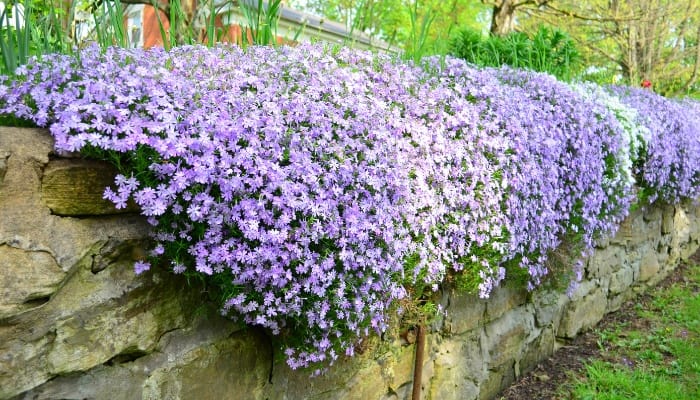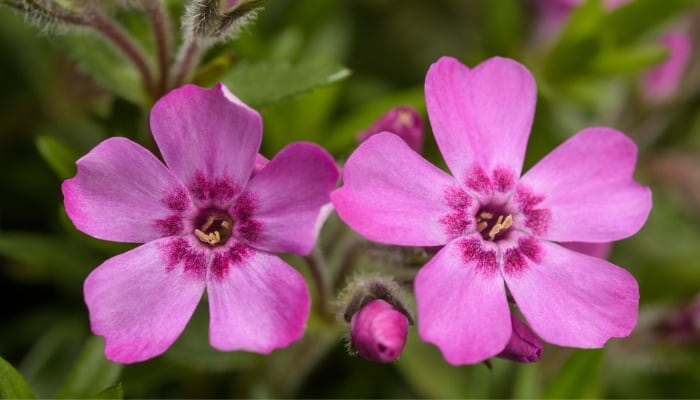It can be challenging to find species of plants that deer won’t eat, as they tend to be quite adventurous in their food choices. However, there is a solution in the form of creeping phlox, available in various colors that not only beautify your yard but also serve as a natural deer repellent.
Deer do not like to eat creeping phlox. It is considered deer resistant because the flowers give off a fragrance and the leaves have a sticky sap and small needle-like hairs, all of which deer find repelling. Planting phlox in your garden can help prevent other varieties from being eaten as well.
Planting creeping phlox is easy, and it will naturally spread to cover the ground quickly!
Read on to understand why it is deer resistant, how to protect your garden from deer, and how to keep it thriving!
Creeping Phlox and Deer – What To Know
Creeping phlox is a lovely perennial ground cover that will bloom seasonally in the spring.
While deer forage for food as the season warms in spring, they will usually eat anything, but creeping phlox will deter them with its natural characteristics.
Is Creeping Phlox Deer Resistant?
Creeping phlox is deer resistant, but in times of scarce food, deer may try it out. In most cases, they won’t come back for seconds because it isn’t the tender sweet green that they usually enjoy.
What Does Deer Resistant Mean?
Deer resistant doesn’t mean deer proof, and in some sense, nothing is deer proof! Deer are foragers who are willing to nibble on anything that looks tender, including creeping phlox.
Being resistant simply means that deer typically choose not to eat it and that planting it nearby can help to prevent deer from thinking there is anything tasty in your garden.
This helps to prevent them from trying anything else in your landscape if planted strategically.
Why Deer Will Likely Avoid Creeping Phlox
Deer prefer tender greens that do not have any attributes that will taste bad or harm their mouths.
Creeping phlox checks a few of those boxes because it has a fragrance, it grows small spiky hairs that cause irritation, and the sap it carries is sour and sticky.
When Deer May Eat Creeping Phlox
Since early spring in cooler climates is a time when everything begins to grow once again, there is still a limited supply of food for the deer to eat.
In this case, deer may begin to become desperate, eating anything, even if it isn’t their preferred food.
How To Protect Creeping Phlox From Deer
While your creeping phlox should keep the deer at bay by their scent, texture, and taste, sometimes deer are hungry and can’t find anything else to eat.
Read more about alternative methods to keep deer from eating your creeping phlox or any other varieties of plants they normally consume.
Motion Activated Sprinklers
All you need to do is plug in your hose, and position the device in the area the deer come from. When the device “sees” an animal crossing its past, it will shoot harmless water like a sprinkler to scare the deer.
They’ll never visit the garden again! You can also set it to go off at timed intervals to always have a deterrent active in your garden.
Ultrasonic Animal Repeller
These emit a high pitch sound, usually tuned to affect deer and other critters, but they are too high-pitched for humans to be bothered by. They are solar-powered and usually create an uncomfortable area for the animals to be in.
Liquid Deer Repellent
Animals usually have heightened senses when it comes to smell and sound.
This repellant uses common smells like garlic and putrescent egg materials to create an area no animal will want to be in. One whiff or taste will keep them from ever wanting to snack in your garden again!
Cayenne Pepper
Just as it is spicy to humans, deer and other critters will find the smell and taste of cayenne pepper uncomfortable.
Simply sprinkle it around your garden, and once the critters experience its strong scent or taste, they won’t want to stop by again.
Interplant With Other Deer Resistant Plants
Creeping phlox is considered deer resistant, but that doesn’t mean it’s deer proof. Planting it with other deer-resistant species will help to create a garden of plants deer don’t like!
They’ll have nothing to feast on in your landscaping, so odds are, they won’t be back again.
Other types of plants that are considered deer resistant are marigolds, foxglove, mint, rosemary, African lily, and crepe myrtle to name a few.
When To Plant Creeping Phlox

The best time to plant creeping phlox is in the spring. It can be planted anytime the weather is warm enough, but planting it early in the season will allow you to enjoy its blooms and will allow the plant to have all season to root and establish.
How Far Apart To Plant Creeping Phlox
When planting an area of creeping phlox, it isn’t necessary to plant them too closely. Anywhere from 18 inches to 2 feet apart is best since the plants will grow outward, spreading to cover any available soil surface.
Creeping Phlox Growing Conditions
Creeping phlox is a hardy variety of plants that isn’t finicky when it comes to soil type. It prefers well-draining soil that is hummus rich and kept moist, but it will spread into almost any area it can.
Plant it in full sun or lightly shaded areas to maximize its flowering potential. This will also help to spread to cover the ground quickly.
Related Questions:
Is There a Creeping Phlox That Blooms All Summer?
While a lush patch of creeping phlox flowers all summer would be beautiful, there are no varieties that bloom past spring and early summer.
If you are looking for year-round blooms, plant garden phlox. It begins flowering in mid to late summer.
What Colors Does Creeping Phlox Come In?
Creeping phlox will bloom in colors of white, pink, purple, and light blue, depending on the variety. Some varieties will be a solid color while others will be color combinations like white and pink or purple.
Is Garden Phlox Deer Resistant?
Garden phlox (Phlox paniculata) is also deer resistant! Since this type of phlox is scented, deer tend to stay away from it.
It has a taller growth habit than its creeping relative and grows to around 3 or 4 feet tall, so it can be used to create a deer-resistant border around your garden!
It also blooms later in the season, so it is great to plant alongside creeping phlox for blooms in the spring through late summer.
Conclusion
While deer are beautiful and always fun to see, they have no need to eat your beautiful flower blossoms.
While creeping phlox is deer resistant, deer are curious creatures who may find it tastier than we like to think.
Try one of the methods listed to keep them out of your garden if they’ve taken a liking to your plantings.

